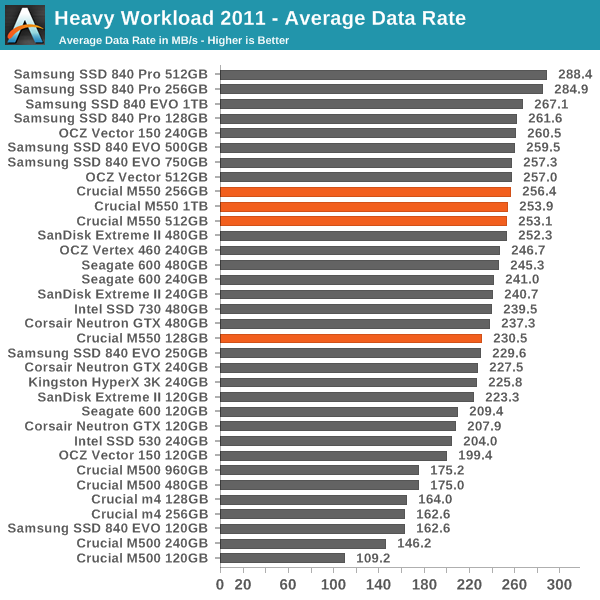Crucial M550 Review: 128GB, 256GB, 512GB and 1TB Models Tested
by Kristian Vättö on March 18, 2014 8:00 AM ESTAnandTech Storage Bench 2011
Back in 2011 (which seems like so long ago now!), we introduced our AnandTech Storage Bench, a suite of benchmarks that took traces of real OS/application usage and played them back in a repeatable manner. The MOASB, officially called AnandTech Storage Bench 2011 - Heavy Workload, mainly focuses on peak IO performance and basic garbage collection routines. There is a lot of downloading and application installing that happens during the course of this test. Our thinking was that it's during application installs, file copies, downloading and multitasking with all of this that you can really notice performance differences between drives.
We tried to cover as many bases as possible with the software incorporated into this test. There's a lot of photo editing in Photoshop, HTML editing in Dreamweaver, web browsing, game playing/level loading (Starcraft II & WoW are both a part of the test) as well as general use stuff (application installing, virus scanning). We've included a large amount of email downloading, document creation and editing as well. To top it all off we even use Visual Studio 2008 to build Chromium during the test. The test has 2,168,893 read operations and 1,783,447 write operations. The IO breakdown is as follows:
| AnandTech Storage Bench 2011 - Heavy Workload IO Breakdown | |
| IO Size | % of Total |
| 4KB | 28% |
| 16KB | 10% |
| 32KB | 10% |
| 64KB | 4% |
Only 42% of all operations are sequential, the rest range from pseudo to fully random (with most falling in the pseudo-random category). Average queue depth is 4.625 IOs, with 59% of operations taking place in an IO queue of 1. The full description of the test can be found here.
AnandTech Storage Bench 2011 - Heavy Workload

AnandTech Storage Bench 2011 - Light Workload
Our light workload actually has more write operations than read operations. The split is as follows: 372,630 reads and 459,709 writes. The relatively close read/write ratio does better mimic a typical light workload (although even lighter workloads would be far more read centric). There's lots of web browsing, photo editing (but with a greater focus on photo consumption), video playback as well as some application installs and gaming. The I/O breakdown is similar to the heavy workload at small IOs, however you'll notice that there are far fewer large IO transfers.
| AnandTech Storage Bench 2011 - Light Workload IO Breakdown | |
| IO Size | % of Total |
| 4KB | 27% |
| 16KB | 8% |
| 32KB | 6% |
| 64KB | 5% |

Even with our older (generally less demanding) workloads, the M550—like the M500—don't really stack up all that well compared to the top performers. Provided the pricing is right, we can overlook a lot of this, but if you're after top performance there are definitely better SSDs.










100 Comments
View All Comments
anh14 - Thursday, March 20, 2014 - link
you nailed that ; all differences are just academic . Everyone always talks about 'faster' but not about how preventing it of making your computer slower i.e. taking your storage of the critical paththe only thing with the earlier SSD's are some of them become excessively slow and resetting them is a pain.
I have a stack of patriots 32Gb that are collecting dust and that OCZ Vertex 2 64 SSD, interesting you mentioned it, I do have that one still but it is my backup C-disk that is in my drawer (e.g. if things go south, I replace the intel 520 I am now using have with this guy which is still better than any slow poke HD)
nathanddrews - Tuesday, March 18, 2014 - link
Coming from a HDD, any modern SSD will be subjectively comparable. Unless you've got a really read or write heavy task, it's really just splitting hairs. I've owned eight SSDs since I bought my first 80GB Intel SSD and I still have all of them in working order (only the largest/newest ones are boot drives, the rest are in external enclosures or serve as scratch drives). Anyway, until we get an interface with considerably higher speed (1-2GBps) and a cost per GB of $0.25 (2TB SSD for $500), the SSD market is just boring IMO.hojnikb - Tuesday, March 18, 2014 - link
We are already headed to sata-express + flash is rapidly getting cheaper nowdays, so 2TB ssd for a reasonable price is not that far away. Another dieshrink (so we get 256Gbit dies) and maturing of sata-express controllers and this will become a reality.jospoortvliet - Thursday, March 20, 2014 - link
Prices haven't really been going down all that fast lately so I wouldn't count on it anytime soon.dishayu - Thursday, March 20, 2014 - link
Sadly,I have to agree with this. I bought a 128GB Plextor M5 in mid 2012 for 84$. That's still the price point where 128GB SSDs sell today.hojnikb - Thursday, March 20, 2014 - link
You do realize u got a heck of a deal for that ssd, right ?Death666Angel - Friday, March 21, 2014 - link
Prices for small capacity SSDs have been relatively stable, but the 256/512 sizes have really dropped. I remember buying a 500GB Samsung 840 for 320€ (December 2012) and the equivalent Evo 500GB now costs 210€.hojnikb - Thursday, March 20, 2014 - link
I disagree.Just check m500 prices lately..
HisDivineOrder - Tuesday, March 18, 2014 - link
Pricing is the thing they need. Performance gets ridiculous past a certain point with the given ports we have.GASOLINENL - Tuesday, March 18, 2014 - link
I read a very technical article about this. In theorie SSD's survive 75 years. Due to different things a very heavy user (lots of writing etc) will kill a SSD after 25!!!! years. So they are great.